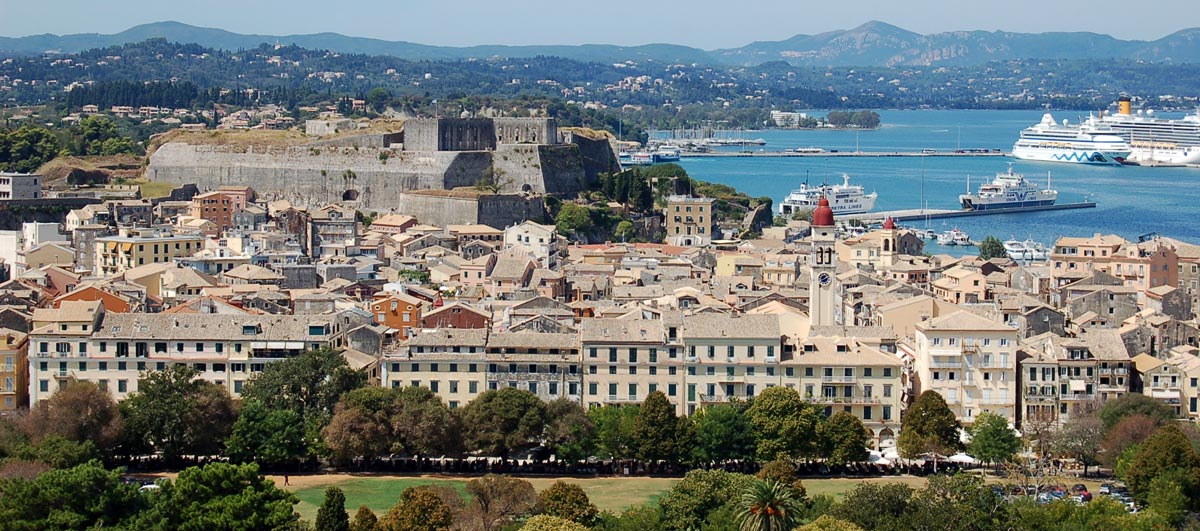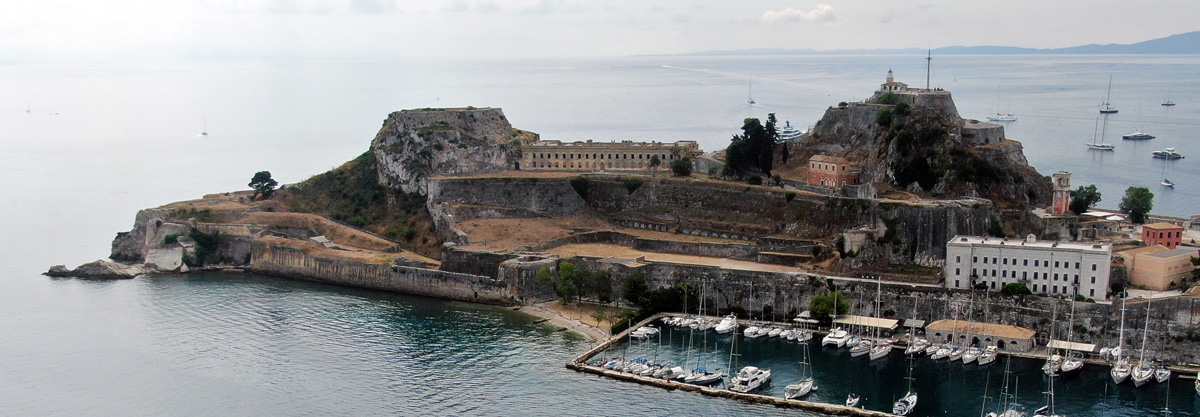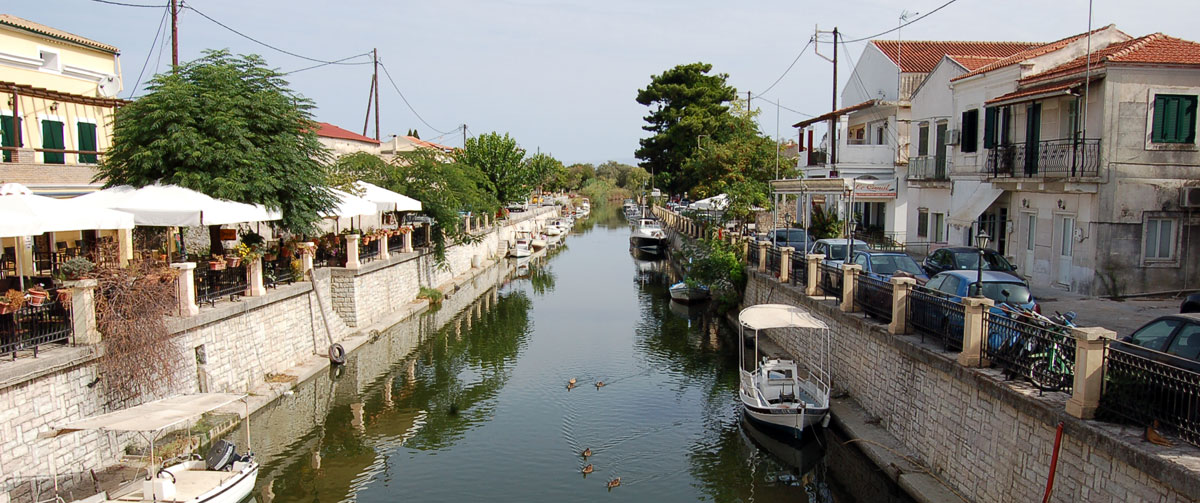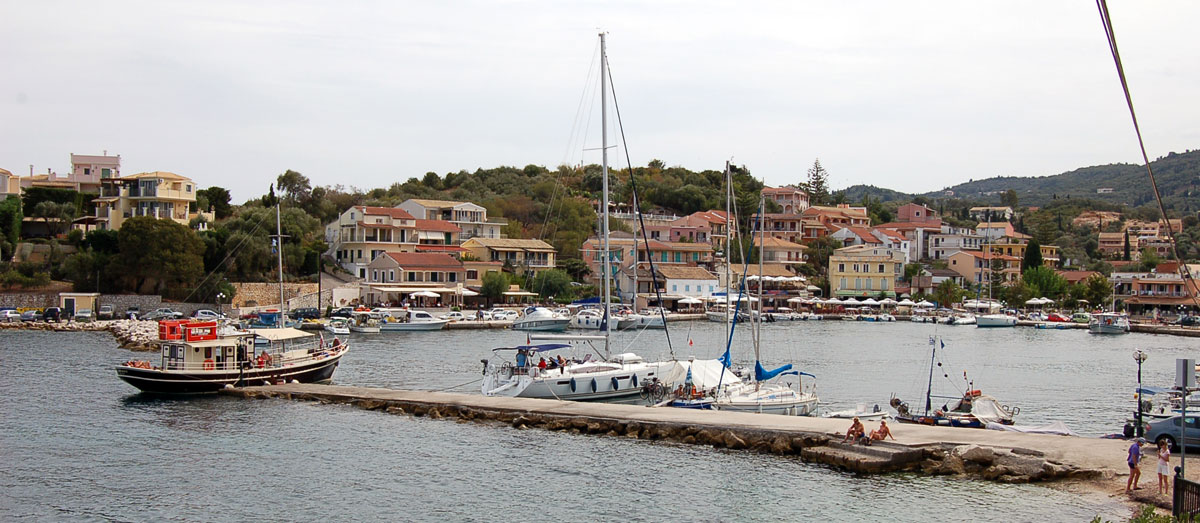
There are different versions as from where the name of the island derived. According to mythology, the island was named Kérkyra when god Poseidon took the nymph Kérkyra and installed her on the island where she gave birth to Faiakas. Historically, the name is suspected to be of Illyrian origin, from the word “Kerkouros” which means light ship. Other names of the island in antiquity were “Drepáni” due to its shape (“drepáni” means “cradle”); “Mákris” due to is length (“mákris” means “long”) and “Schería” as the goddess Dímitra, asked Poseidónas to stop (“scheín” meaning “stop”) the mud from the opposite river Thýami in order to prevent the joining of the island to the mainland.
In the Byzantine years, the island was named “Koryfó” due to the twin-peaked (“koryfí” means “peak”) citadel of the island’s capital. From the Byzantine name, paraphrased, the Latin name of the island “Corfu” came to be.
In mythology, Iásonas and Mideia came here hunted, during their return from the Quest of the Golden Fleece. They found shelter on the island and were married here (“Argonautica” by Apolloníos). Later, the shipwrecked Odysséas was welcomed to the island by Nafsiká, daughter of King Alkínoos (“Odýsseia” by Homer).
Historically, the Illyrians were probably the first settlers and lived here up until the 8th century BC, when between 775 – 750 BC the island was colonized by Erétrians (Évvoia) and subsequently (730 BC) by the Korinthians, who quickly developed it into an independent city-state with commercial and nautical might.
However, this rapid development annoyed the parent state of Kórinthos, who sent its fleet in order to conquer Kérkyra. Another reason for the conflict between the two states was that Kérkyra wanted democracy and the Korinthians favoured oligarchy. The sea battle between them occurred in 664 BC (Thoukididis writes that it is the most ancient sea battle) and unfortunately, democracy lost.
At the end of the 3rd century BC, Kerkyra turned to Rome for aid against the constant piratic raids. The aid came and together with it, the Roman legions, who conquered the island and held it up until mid 4th century AD.
During the Byzantine years, the island was weakened by several raiders like the Vandals of Germany, the Goths of Italy and the Saracens of Arabia.
In 11th century AD Kérkyra was conquered by the Norman Robert Wiscard however it was soon freed (1147) by the valiant emperor Emmanuel Komninos of which it is said, “the king fought like a plain soldier”. In 1204 the island was occupied by the Venetians, but freed again by the Greeks 8 years later (at that time, Angelókastro was founded).
At the end of the 13th century, Kérkyra became part of the territories of the King of Naples in Italy and remained for over a 100 years. At the end of the 14th century, the Venetian rule was established for good and lasted for 4 centuries (up to the end of the 18th century). After the fall of the Constantinople to the Turks (1453 AD), the relics of Saint Spyrídonas and Saint Theodóra were brought to the island.
The Turks attempted on numerous occasions to subdue the island but failed. On 18th August 1537, the renowned pirate Barbarossa, who was already chief admiral of the Sultan Suleiman the Magnificent, tried to take the stronghold of the city but failed. As he left the island, he took 20,000 people (almost half the population of the island) from the countryside as slaves. In 1716 the Turks once again seriously threatened the stronghold of the city. The brave German General von der Schulenburg, leader of the defense, fought desperately. The Turkish siege was broken by a strong storm that sank almost the entire Turkish fleet. The Kerkyrians ascribe the storm to a miracle performed by the protector of the island, St. Spyrídonas, and ever since they celebrate the event on the 11th of August every year.
In the years 1800 to 1864, the island was occupied first by the French and then by the English, after which it was finally reunited with mother Greece.
Today, Corfu is a most beautiful and green island, with immense touristic development. The island offers something for everybody, cosmopolitan life, nightlife, theatre, music, art, museums, castles, churches but also unparalleled natural beauty, endless sandy beaches, unique landscapes.

Corfu town: During the 7th century AD, the inhabitants of Kérkyra abandoned the old city which was located in the peninsula of Análypsi, and built the Byzantine city where it lies today. The chosen location was on the fortified place of the two-peaked peninsula, where the Old Castle stands today (this location is called “Akrópolis” and is mentioned in the scripts of the historian Thoukydídis).
In the Venetian years, the defense works and fortification were enhanced significantly. Initially, the castle was reinforced and a canal (Contra-Fossa) was opened, so that the small two-peaked peninsula was transformed to an island that was joined with the rest of the island by a mobile bridge. Then, walls surrounding the city were built, which extended outside the castle (the northern part of these walls was called “mouragia”), as well as a new castle. The fortifications were concluded with the building of two more castles, one of which is used today as criminal prison. Last, the small harbour “Mandráki” was built for the sheltering of warships.
Most of the fortifications were destroyed by the English, before delivering the island to Greece in 1864. During the 2nd World War, the city suffered from continuous bombarding, from enemies and allies, which worsened the state of this city’s historic legacy. Entire districts and many beautiful buildings, which used to decorate the city, were ruined. However, a fact indicative of the city’s rich past, there are still quite a few monuments to be admired, in Corfu’s streets and museums.
The city displays the largest and most beautiful square of Greece, “Spianáda”. Impressive buildings of the 19th century and splendid arches under the buildings of Liston surround this square. It owes its existence to the need to have a clear space in front of the old castle so that the enemy would be unable to surprise the defenders and, upon attack, be exposed to the firepower of the castle.

Lefkímmi: One of the largest villages of Corfu. What is unique in Lefkímmi is that it is untouched by tourism, has kept its traditional structure and colours and is occupied by locals all year round. It is a place that remained in the lifestyle of the old days and for that alone, it is worth visiting (no draught beer there).

Kassiópi: One of the most touristically developed villages of the northern part of Corfu. It was built initially in antiquity by fishermen. During the Roman times, it prospered as it lied on the sailing routes of that era’s ships.
Today it is a picturesque village with its own charm, 2 bays with their beaches to the east and west, separated by a peninsula with the ruins of a Byzantine castle. Lately, it has been under siege again, by the endless hordes of tourists coming from every quadrant.

Achílleio: The palace of Elisabeth (Sissy), Queen of Austria, also known as the sad queen. The sensitive queen was taken by Kérkyra and following the improvement in her health, due to its good climate, she decided to built this summer palace to which she could withdraw from time to time, where she could sink into her thoughts and her poems. Her love towards the mythical hero Achilléas, gave her the incentive to decorate it and name it after him. The well-photographed statue of “dying Achilléas”, decorates the garden of the palace.
Today, Achílleio is a museum which you can visit, however the last years has been closed to the public for renovation works. Call before you visit.


